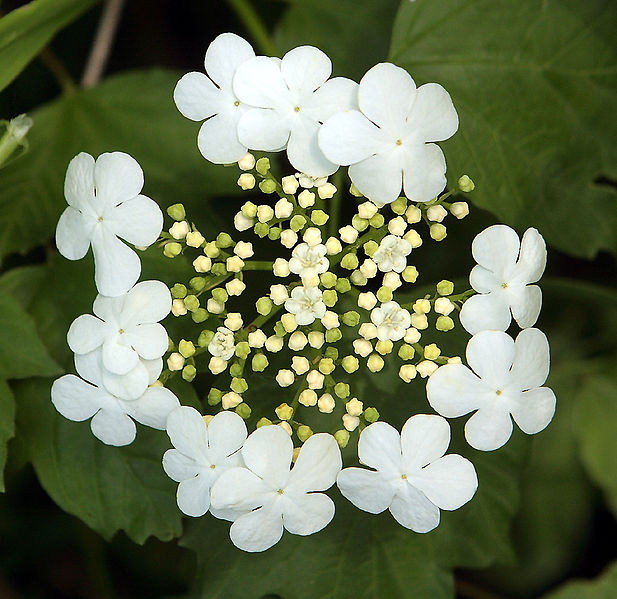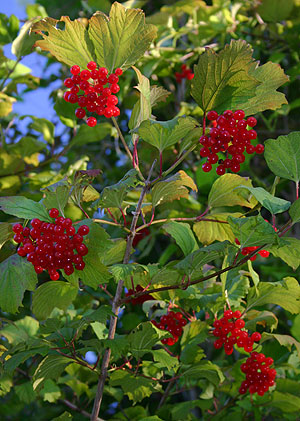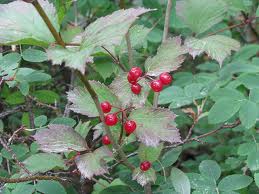I miss High Bush Cranberries. They don’t grow within a thousand miles of here, and they aren’t really cranberries. But they are hearty and familiar fare in northern climes.
The High Bush Cranberry is actually a Viburnum (Viburnum trilobum) and a cousin of the elderberry. Both are in the greater Honeysuckle Family and have a characteristic musky odor. That family by the way straddles the edibility line, with some members edible and others not, some tasty and some not. As one might suspect by the name, the High Bush Cranberry has tart fruit. Bradford Angier, a well-known Canada-based forager along side Euell Gibbons, wrote they require a “conditioned palate” to appreciate.
In North America the High Bush Cranberry is found in Canada and the northern half of the United States plus, oddly, New Mexico. It is not as that friendly to wildlife as one might suspect. The fruit persists into the winter because they are not on the top of birds’ preferred food. Birds like the berries after they soften and ferment. White-Tailed deer also browse on the twigs and leaves. For humans the berries are high in Vitamin C, about 30 milligrams per 100 grams.
Viburnum trilobum has several disputed botanical names and several mistaken common names including Pimbina, Mooseberry, Cranberry Tree, Cranberry Bush, American Cranberry, and Squashberry. Around the world there are at least 10 Viburnums and several cultivars used for food or tea. Among them are: Viburnum alnifolium, Viburnum cassinoides, Viburnum edule, Viburnum lentago, Viburnum nudum, Viburnum opulus, Viburnum opulus xanthocarpum, Viburnum prunifolium, and Viburnum setigerum. In North America V. trilobum, and V. edule are preferred. Generally native North American species taste better than imported European species. This holds true for elderberries as well.
Uncharacteristically “Viburnum” (vye-BUR-num) is not bastardized Greek but dead Latin for “wayfaring tree.” A Eurasian shrub, Viburnum lantana, is called the wayfaring tree because it grew beside trails that are now roads. Trilobum (try-LOW-bum) means three lobes, a reference to the leaves. Edule (ED-yew-lee) means edible.
Green Deane’s “Itemized” Plant Profile: High Bush Cranberry
IDENTIFICATION: Viburnum trilobum: A deciduous shrub to 12 feet (4 m) tall. Bark gray and rough, scaly. Stems arch, dense, twigs reddish-brown. Leaves opposite, palmate, three-lobed, five inches (6-12 cm) long and nearly as wide, rounded base, serrated edge, resemble maple leaves but with a wrinkled surface. Flowers white, unpleasant aroma, resemble hydrangeas, four inches across (13 cm) in corymbs with a ring of large sterile blossoms surrounding a center of small, fertile flowers. Fruit an oblong red drupe, 5/8 of an inch (15 mm) long and about a half inch (12 mm) wide, one flat, white seed. Shrub fruit around five years old.
TIME OF YEAR: Flowers in late spring, fruits in late summer, fruit persists into fall and winter.
ENVIRONMENT: Full sun or partial shade, woods and moist meadows, well-drained soil. Moist is important. Can be trained to be a hedge, favored for colorful foliage both in the spring and fall.
METHOD OF PREPARATION: The fruits are sour with a lot of pectin, can be eaten raw or cooked. Fruit in the early fall can be bitter but can be made into excellent jelly, jams, and syrups for pancakes, meat and game. The flowers can be added to pancake batter or the like and made into fritters. Some think the berries taste better after one or two frosts, others think they are best collected before a frost. It is a conflict of taste and texture, sometimes a confusion of species.





Darn… I thought you were going to tell us you found some growing in Florida!
Great for jelly. Can be mixed with almost any other berry or apples to make great jelly. Good to use like any other jelly or jam and also great for making sauces for turkey, pork, chicken and especially meatballs.
I just found 3 bushes full of these. They look like they are ripe, but yuch, they are not yet. As they are a member of the elderberries, of which I am a big fan, I rather think they will need some sugar to make them palatable. I will keep checking them, and wait til frost. They are beautiful just to look at as well as maybe make some jam or jelly out of for winter.
I tried some high bush cranberry that I found here in Michigan, I don’t know what it is, the soil, the pickle factory nearby or what. But they had to be the most revolting things I tasted. They tasted so tart it was almost rot flavored. I immediately spat out the juice and it left a nasty aftertaste for half an hour. Blegh
I live in Ontario, and I found a bush while on a hike and ate one because I was hungry. Not the best, highly suggest wild blueberries, currants, cloud berries, mulberries, currants, normal “low bush” cranberries ,strawberries or raspberries. (trust me they taste better) They provid a much tastier snack
There are quite a few of these growing around the small northern NY village where I live. I haven’t tried cooking with them, but after reading that they’re high in pectin, I might try some jam from them this year. I’ve found at least one recipe for it, on a site called Taste of Home. Since it mentions using orange zest, it occurs to me that orange Jello might be another possibility to enhance the flavor. Although I know that these berries are not related to regular cranberries, I believe my experience in cooking the latter with orange Jello, might be applicable to this wild berry, as well.
They are also native to northern Alberta. Walking through the woods, one gets the aroma, much like yeast, quite musty.
Didn’t like the jelly for use with anything except meat, as you would with regular cranberries. I wouldn’t go out of my way to make the jelly again, as there are so many other good berries in the woods.
I love the highbush cranberries, picking as well as eating. They make great jelly and pancake syrup and the color is beautiful. They aren’t something you pick and eat while out in the woods. I now have a juicer that I use to process them raw so it is much quicker than hand pressing the juice or cooking them. My husband dehydrates the mulch left by the juicer and uses the dried part for tea.
there is a bog near where I live and several bunches of bushes about 1.5 meters tall that are loaded with clusters of red berries . Would they be cranberries?
We planted 50 high bush cranberries in an area by out pond. This is the first year they have lots of berries. I went out with my grand daughter to pick some. She thought they smelled bad, and tasted very sour. I mixed them with some very sweet plums to make jam. Did not need to add any pectin , jam turned out nice, beautiful colour and nice , bit tangy taste.
We live in Ontario.
We bought 8 plants from Miller’s (since sold to Stark) in Canandaigua NY about 3 years ago’ supposedly edible. Got some berries this year. Have done some reading and must believe we have opulus. Flavor is BITTER. Not “sour” or “tart.” Leaves, cluster size, and leave stems all indicate the inedible opulus.
What a shame!
We grew them in upstate NY, they did fine. If I can find some edule for sale, we’ll try all over again. May have to settle for trilobum.
Anyone with definitive info??
How long to grow from seed? Where can I get edule?
Thanks.
If you would like to grow your own true, great-tasting native Viburnum edule, you can order from the following company: Fraser’s Thimble Farms, Salt Spring Island, BC, Canada. Viburnum edule (squashberries) can still be found all over Newfoundland, as well.
I got a couple highbush cranberries from our conservation district’s annual plant sale. They focus on bird plants, native hedges and trees, and fruit trees. The highbush cranberries were sold as bird and people food. Not this people. I think mine are opulus, as well. As another poster said, not sour or tart, and even bitter doesn’t quite cover it. Yucky is closer. The flowers are quite lovely, and the berries are pretty and hang on a long time. But these are going to go. My lot is too small for plants that it looks like the birds don’t even want. Gwen, thanks for the hints on where to get edule. Though I am thinking that perhaps with my small lot, I need to just stick with smaller plants.
I have pick a lot of highbush cranberries washed and cooked them and made juice and put 4 cups in a zip lock freezer bag and put them in the freezer I sell them for $15 a bag. all you have to do is add sugar lemon juice and certo to make jelly or syrup for 80% of the work is down. you can reach me at diehl.dolores@yahoo.com or at 587 991 7594